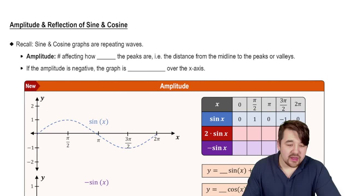Table of contents
- 0. Review of College Algebra4h 43m
- 1. Measuring Angles39m
- 2. Trigonometric Functions on Right Triangles2h 5m
- 3. Unit Circle1h 19m
- 4. Graphing Trigonometric Functions1h 19m
- 5. Inverse Trigonometric Functions and Basic Trigonometric Equations1h 41m
- 6. Trigonometric Identities and More Equations2h 34m
- 7. Non-Right Triangles1h 38m
- 8. Vectors2h 25m
- 9. Polar Equations2h 5m
- 10. Parametric Equations1h 6m
- 11. Graphing Complex Numbers1h 7m
4. Graphing Trigonometric Functions
Graphs of the Sine and Cosine Functions
Problem 35d
Textbook Question
In Exercises 35–42, determine the amplitude and period of each function. Then graph one period of the function. y = cos 2x
 Verified step by step guidance
Verified step by step guidance1
Identify the standard form of the cosine function, which is \( y = a \cos(bx + c) + d \).
In the given function \( y = \cos(2x) \), compare it with the standard form to find the values of \( a \) and \( b \). Here, \( a = 1 \) and \( b = 2 \).
Determine the amplitude of the function. The amplitude is the absolute value of \( a \), so \( \text{Amplitude} = |1| = 1 \).
Calculate the period of the function. The period is given by \( \frac{2\pi}{b} \). Substitute \( b = 2 \) to find the period: \( \text{Period} = \frac{2\pi}{2} = \pi \).
Graph one period of the function \( y = \cos(2x) \) by plotting points from \( x = 0 \) to \( x = \pi \), noting that the cosine function starts at its maximum value, decreases to its minimum, and returns to its maximum over one period.
Recommended similar problem, with video answer:
 Verified Solution
Verified SolutionThis video solution was recommended by our tutors as helpful for the problem above
Video duration:
8mPlay a video:
Was this helpful?
Key Concepts
Here are the essential concepts you must grasp in order to answer the question correctly.
Amplitude
Amplitude refers to the maximum height of a wave from its central axis. In trigonometric functions like cosine, it indicates how far the function reaches above and below its midline. For the function y = cos(2x), the amplitude is 1, as the cosine function oscillates between -1 and 1.
Recommended video:

Amplitude and Reflection of Sine and Cosine
Period
The period of a trigonometric function is the length of one complete cycle of the wave. For the cosine function, the standard period is 2π. However, when the function is modified, such as in y = cos(2x), the period is adjusted by the coefficient of x, resulting in a new period of π, meaning the function completes one full cycle in that interval.
Recommended video:

Period of Sine and Cosine Functions
Graphing Trigonometric Functions
Graphing trigonometric functions involves plotting the values of the function over a specified interval. For y = cos(2x), one period can be graphed from 0 to π, showing the characteristic wave shape. Understanding the amplitude and period is crucial for accurately representing the function's behavior on a graph.
Recommended video:

Introduction to Trigonometric Functions

 5:53m
5:53mWatch next
Master Graph of Sine and Cosine Function with a bite sized video explanation from Nick Kaneko
Start learningRelated Videos
Related Practice
















